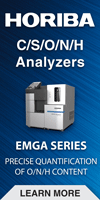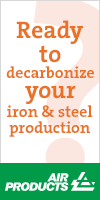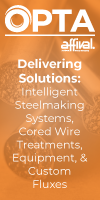Steel Making a Comeback in Automotive Steel Wheels
11/13/2004 - Steel wheels, once facing a rapid decline in use, are making a strong comeback as automakers realize they can save up to $100 per vehicle without sacrificing quality or performance. DaimlerChrysler Corp., Ford Motor Co. and General Motors Corp., plus many European and Asian carmakers, are changing back to steel wheels for base wheels as well as for upgrade packages.
|
Steel wheels, once facing a rapid decline in use, are making a strong comeback as automakers realize they can save up to $100 per vehicle without sacrificing quality or performance. DaimlerChrysler Corp., Ford Motor Co. and General Motors Corp., plus many European and Asian carmakers, are changing back to steel wheels for base wheels as well as for upgrade packages.
At DaimlerChrysler Corp., three variations of the Dodge Ram 1500 are available with steel as the base wheel. The Ram 1500 ST base wheel is painted while the SLT and SLT+ feature styled chromed steel for base wheels. Both styled aluminum and styled steel wheels are available in upgrade packages.
At General Motors Corp. (GM), approximately two million aluminum wheels will be replaced by steel. This example of steel's comeback features the Flex Wheel, which GM is using to replace aluminum in a number of car models. The Flex Wheel has a high-strength steel (HSS) 410 MPa (wield) bainitic rim and a dual-phase (DP) 600 MPa (tensile) disc. The Flex Wheel offers a structurally efficient backbone steel wheel with large openings with a spoke-like appearance. When combined with attractive permanent trim, a good-looking wheel is obtained at significant cost savings over cast aluminum.
At Ford Motor Co., significant progress in regaining steel market share is being made in light trucks and sports utility vehicles (SUV). The Ford F-150 Lariat light truck and the Lincoln Navigator SUV feature newly styled steel wheels with permanent trim.
In several surveys of consumer preferences, styling was considered more important than safety, price or warranty. However, in comparing wheel styling (steel versus aluminum), consumer surveys show that there is little preference for one material over another. The perception is that steel is stronger and safer, while aluminum is lighter. As an example, the PT Cruiser has styled steel wheels, with each wheel weighing 17.0 pounds. Compared to the aluminum wheels for the PT Cruiser, which weigh 16.9 pounds, there is little difference in mass. The steel wheel has an HSS 550 MPa (tensile) bainitic steel rim and a DP 600 MPa (tensile) disc.
|
According to Ron Krupitzer, Senior Director, Automotive Applications for the American Iron and Steel Institute (AISI), "Our Wheels Task Force, comprising OEMs, wheel manufacturers, and steel companies, has been aggressive in its efforts to develop new wheel designs and apply new high-strength materials."
"The Task Force has studied OEM requirements and consumer preferences. Safety and appearance are important to both groups, while profitability is a key factor for automakers," said Krupitzer. "The benefits from our work on permanent trim and the use of high-strength steels have been substantial."
Background—During the 1980s, with the growing emphasis on fuel economy and the need to reduce vehicle weight, automakers were turning to alloy wheels with aluminum leading the charge to grab market share once almost exclusively steel. Hurt by the loss, steelmakers enlisted the help of wheel manufacturers and OEMs and launched a campaign to create new wheel styling and explore the use of new steels. The effort was highly successful. Using bright materials like stainless steel that attach permanently to the wheel and modifying disc and rim designs to enhance styling, wheel manufacturers satisfied consumers' desire for decoratively styled wheels. Consumers indicate that decorative steel wheels are on a par with aluminum wheels with respect to looks.
In the late 1980s, wheel makers switched from the traditional mild steel (240 MPa yield to 350 MPa tensile) for wheel discs and rims to a high strength low alloy material (450 MPa tensile for disc and rim).
The steel industry continued to explore ways of achieving higher strength steels for wheels, first through precipitation hardening and then through transformation hardening Bainitic Steels that exhibited improved formability and weldability with very good fatigue performance. Bainitic materials permitted a 5% weight reduction, and were used by Toyota, DaimlerChrysler, and Honda.
Then in the early 2000s, it was an Advanced High-Strength Steel, Dual-Phase that caught the attention of wheel makers. Dual-Phase steels, currently used for wheel discs, exhibit good strength, formability and durability.
AISI serves as the voice of the North American steel industry in the public policy arena and advances the case for steel in the marketplace as the preferred material of choice. AISI also plays a lead role in the development and application of new steels and steelmaking technology. AISI is comprised of 31 member companies, including integrated and electric furnace steelmakers, and 118 associate and affiliate members who are suppliers to or customers of the steel industry.
The Automotive Applications Committee (AAC), a subcommittee of AISI’s Market Development Committee, focuses on advancing the use of steel in the highly competitive automotive market. With offices and staff located in Detroit, cooperation between the automobile and steel industries has been key to its success. This industry cooperation resulted in the formation of the Auto/Steel Partnership, a consortium of DaimlerChrysler Corp., Ford Motor Co. and General Motors Corp. and the member companies of the AAC.


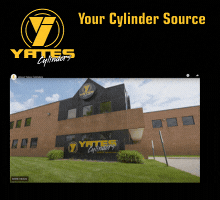
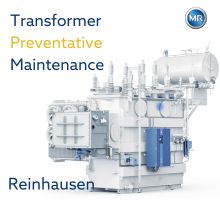-(220-x-200-px)-(130-x-130-px)-(220-x-200-px).jpg?lang=en-US&ext=.jpg)
Veolia.gif?width=200&height=200&mediaprotectionhash=4deca34a0d5a00013b5a0ccdc2dcf98fd2c17aabb57eb7bbb27200552f29c247&ext=.gif)
